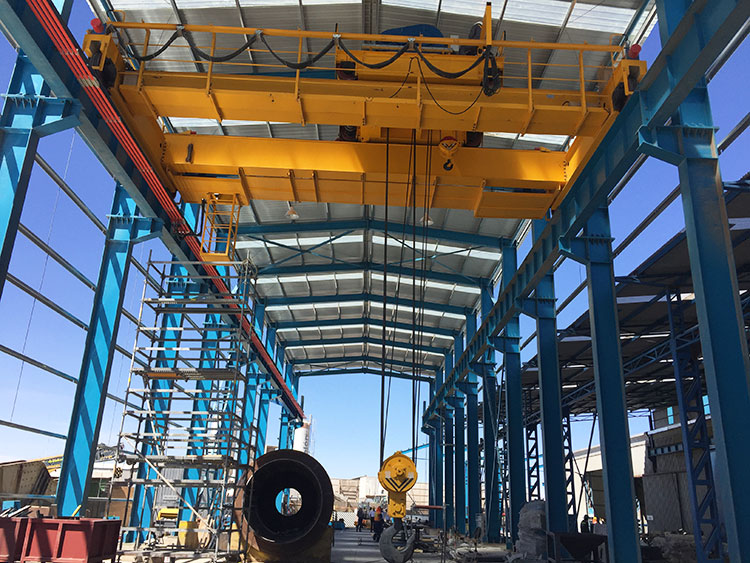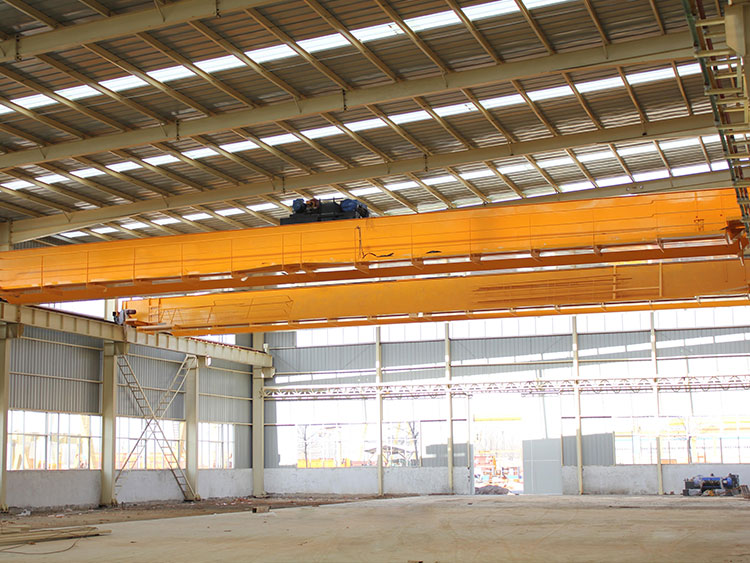Overhead cranes in the 10 to 50-ton capacity range are commonly used in industrial sectors like manufacturing, steel processing, warehousing, and shipbuilding. In designing such cranes, two crucial concepts must be clearly understood and carefully applied: Rated Load and Actual Load. Misunderstanding or misapplying these concepts can lead to safety hazards, structural failure, or inefficient operations. This article explores the key differences between Rated Load and Actual Load, their roles in overhead crane design, and how engineers and crane users should account for each to ensure optimal performance and safety.

What is Rated Load?
Rated Load (also referred to as Safe Working Load – SWL or Nominal Load) is the maximum load a crane is designed and certified to lift under specific conditions. It is determined through detailed engineering analysis and must comply with national or international standards (such as ISO, FEM, ASME, or CMAA guidelines).
For example, a 20 ton overhead crane with a Rated Load of 20 tons is engineered to safely lift up to 20 metric tons of load, provided that all operational parameters—such as load distribution, lifting speed, operating temperature, and usage frequency—are within design limits.
Factors Considered in Rated Load Design:
-
Structural Strength: The crane’s girders, end trucks, and runway beams must withstand the rated load with an appropriate safety factor.
-
Mechanical Components: The hoist, wire ropes, brakes, and gearbox are selected based on the rated load.
-
Load Spectrum and Duty Class: Usage frequency and load cycles affect the fatigue life of components, influencing the rated capacity.
-
Safety Factor: Usually ranging between 1.5 to 2.0, depending on design standards and application.
-
Standards Compliance: Adhering to design codes ensures rated load limits are based on rigorous calculations and safety benchmarks.
What is Actual Load?
Actual Load is the real-time weight of the item being lifted by the crane during a specific lifting operation. It varies from task to task and can range from a few kilograms to the crane’s maximum rated capacity.
For example, although a 10-ton single girder overhead crane has a rated load of 10 tons, it may typically lift loads between 2 and 8 tons in daily operations. The Actual Load is influenced by the load’s shape, center of gravity, attachment methods, and even environmental conditions.
Common Sources of Actual Load Variation:
-
Different materials or components being lifted (e.g., steel coils, concrete blocks, machine parts)
-
Changes in batch sizes or packaging
-
Load plus lifting attachments (slings, spreaders, magnets, etc.)
-
Inaccurate or estimated weight measurements
Key Differences Between Rated Load and Actual Load
| Aspect | Rated Load | Actual Load |
|---|---|---|
| Definition | The maximum designed lifting capacity of the crane | The real load being lifted at any given moment |
| Determined by | Engineers, based on standards and design limits | Operational environment and task requirements |
| Fixed or Variable | Fixed during crane design | Variable in actual use |
| Safety Margin | Includes built-in safety factors | Must not exceed the Rated Load |
| Usage | Basis for crane selection and component sizing | Key for operational safety and efficiency |
Importance of Understanding the Difference in Crane Design
When designing overhead cranes in the 10-50 ton range, both Rated Load and Actual Load must be considered for the following reasons:
1. Component Selection
All structural and mechanical components are selected based on the Rated Load. If designers confuse actual frequent loads with the rated capacity, it may result in under-designed components, increasing the risk of failure. Conversely, overdesigning based on maximum loads that rarely occur can lead to unnecessary costs.
2. Crane Classification (Duty Group)
Standards like FEM or CMAA classify cranes based on usage patterns. For example:
-
CMAA Class C is for moderate service (e.g., machine shops),
-
CMAA Class D is for heavy-duty service (e.g., steel mills).
Understanding how often the crane will lift close to its rated capacity (i.e., evaluating actual load distribution) helps determine the correct duty class and fatigue design parameters.
3. Structural Safety and Fatigue Life
Repeated lifting of high actual loads—even if within rated limits—can cause fatigue in steel structures and welds. The load spectrum (i.e., the distribution of actual loads over time) must be used to evaluate long-term structural integrity.

4. Cost Optimization
Overhead cranes with higher rated capacities typically require larger motors, stronger steel structures, and reinforced foundations. If actual loads rarely exceed half the rated capacity, the crane may be overdesigned, leading to inflated purchase and maintenance costs.
Role of Load Monitoring Systems
Modern overhead cranes often come equipped with load cells, weighing sensors, and load moment indicators. These help in:
-
Monitoring Actual Load in real-time
-
Preventing overload conditions
-
Logging data for maintenance and inspection
-
Improving operator awareness
Such systems enhance safety by ensuring that actual lifting operations remain within the crane’s rated capabilities.
Best Practices for Crane Buyers and Users
1. Know Your Load Requirements
Before you buy overhead crane, perform a detailed load analysis:
-
What are the typical and maximum loads?
-
How frequently are heavy lifts performed?
-
Are there any unusual loads with eccentric centers of gravity?
This data will help match the Rated Load to your real operational needs.
2. Select the Right Safety Margin
While standards specify safety factors, certain applications (e.g., hazardous environments or human transport) may require higher margins. Ensure rated loads are not just technically adequate but conservatively safe.
3. Train Operators
Operators must understand the Rated Load limit and avoid lifting unknown or unmeasured loads. Overloading can cause immediate equipment failure or long-term structural damage.
4. Regular Inspection and Load Testing
Routine inspections and periodic load testing (usually 125% of rated capacity) help verify whether the crane can still safely lift its Rated Load, especially if actual loads are frequently near the limit.
Conclusion
Understanding the difference between Rated Load and Actual Load is essential in the design, selection, and operation of 10 ton to 50 ton overhead crane. While the Rated Load is a fixed engineering parameter based on safety standards and design calculations, the Actual Load is a dynamic, real-world value that varies with each lift. Ensuring that actual loads remain within the rated capacity, and that cranes are designed with realistic usage expectations, leads to safer, more efficient, and longer-lasting lifting equipment. For businesses and operators, awareness of these distinctions can prevent accidents, reduce downtime, and optimize investment in overhead crane systems.